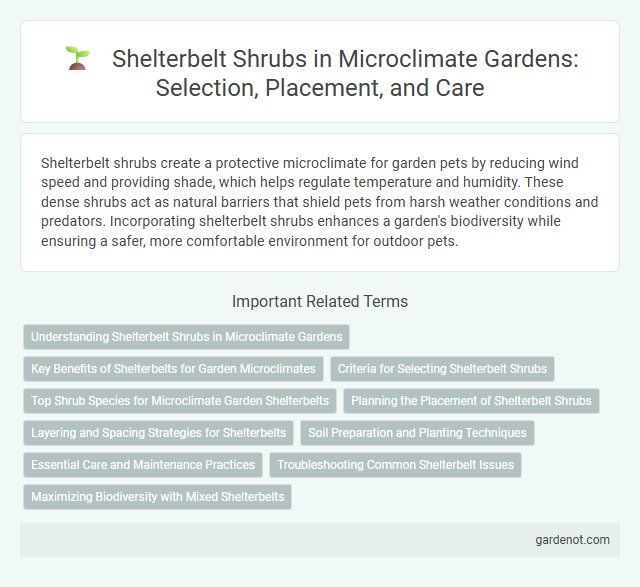Shelterbelt shrubs create a protective microclimate for garden pets by reducing wind speed and providing shade, which helps regulate temperature and humidity. These dense shrubs act as natural barriers that shield pets from harsh weather conditions and predators. Incorporating shelterbelt shrubs enhances a garden's biodiversity while ensuring a safer, more comfortable environment for outdoor pets.
Understanding Shelterbelt Shrubs in Microclimate Gardens
Shelterbelt shrubs play a crucial role in microclimate gardens by providing windbreaks that reduce wind speed and temperature fluctuations. These dense, strategically planted shrubs enhance soil moisture retention and create a more stable environment for delicate plants. Selecting native, hardy species like Juniperus or Cornus maximizes shelterbelt effectiveness in diverse garden microclimates.
Key Benefits of Shelterbelts for Garden Microclimates
Shelterbelt shrubs create windbreaks that reduce wind speed and temperature fluctuations, promoting stable microclimates ideal for plant growth. These dense plantings enhance humidity retention and soil moisture levels, which support healthy root development and reduce evapotranspiration. By providing shade and protection, shelterbelts also contribute to biodiversity, attracting beneficial insects and birds that aid in pest control.
Criteria for Selecting Shelterbelt Shrubs
Selecting shelterbelt shrubs requires considering species with dense foliage, rapid growth, and tolerance to local climatic conditions such as wind, cold, and drought. Opt for native or well-adapted shrubs like hawthorn, juniper, or dogwood that provide year-round protection and enhance biodiversity. Soil compatibility, maintenance needs, and resistance to pests and diseases are critical factors for long-term shelterbelt effectiveness.
Top Shrub Species for Microclimate Garden Shelterbelts
Top shrub species for microclimate garden shelterbelts include hardy varieties such as Amelanchier alnifolia, Cornus sericea, and Caragana arborescens, known for their dense foliage and windbreak efficiency. These shrubs improve local microclimates by reducing wind speed, retaining soil moisture, and providing shade, which enhances plant growth and biodiversity. Their adaptability to various soil types and climates makes them ideal for creating protective barriers in diverse garden settings.
Planning the Placement of Shelterbelt Shrubs
Optimal planning for shelterbelt shrub placement involves analyzing prevailing wind directions and local microclimate data to maximize windbreak efficiency. Positioning dense, multi-layered shrub rows at a strategic distance from crop areas reduces wind speed, minimizes soil erosion, and enhances moisture retention. Selecting species with varying heights and root depths strengthens the shelterbelt's stability and ecological function within the microclimate garden.
Layering and Spacing Strategies for Shelterbelts
Shelterbelt shrub layering and spacing strategies optimize windbreak effectiveness and microclimate regulation by creating multiple vegetation tiers, including tall trees, medium shrubs, and low groundcovers. Proper spacing between shrub layers fosters air circulation while reducing wind speed, promoting soil moisture retention and enhancing biodiversity. Strategic layering and spacing in shelterbelts support microclimate stabilization, improve crop protection, and increase ecological resilience.
Soil Preparation and Planting Techniques
Shelterbelt shrubs thrive in well-drained, nutrient-rich soil amended with organic compost to enhance moisture retention and root development. Planting techniques involve digging holes twice the width of the root ball, ensuring shrub roots spread naturally without bending, and spacing plants according to species-specific growth patterns to optimize windbreak efficiency. Mulching around the base reduces soil erosion and temperature fluctuations, promoting healthy shrub establishment within the microclimate garden.
Essential Care and Maintenance Practices
Shelterbelt shrubs require regular watering during dry periods to establish deep root systems essential for wind protection and soil stabilization. Pruning should be performed annually in late winter to remove dead or weak branches, promoting healthy growth and maintaining density for effective microclimate control. Applying organic mulch helps conserve moisture, regulate soil temperature, and suppress weed growth around the shrub base.
Troubleshooting Common Shelterbelt Issues
Shelterbelt shrubs often face challenges such as pest infestations, drought stress, and nutrient deficiencies that can impair their protective function. Regular monitoring for signs of insect damage, leaf discoloration, and stunted growth enables early intervention with appropriate treatments like organic pesticides or targeted fertilization. Ensuring proper irrigation and soil health management helps maintain the vigor of shelterbelt shrubs, enhancing their ability to reduce wind speed and provide microclimate benefits.
Maximizing Biodiversity with Mixed Shelterbelts
Mixed shelterbelts composed of diverse shrub species significantly enhance microclimate garden biodiversity by creating varied habitats for wildlife and promoting ecological balance. Integrating native and complementary shrub varieties optimizes soil health, supports pollinators, and improves pest resilience. This strategic planting approach fosters a sustainable microenvironment, maximizing ecosystem services within the garden.
Shelterbelt shrub Infographic

 gardenot.com
gardenot.com